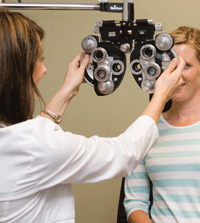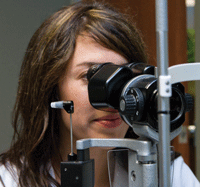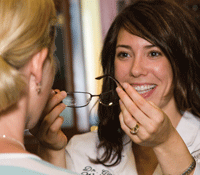How and why did I do this? Because I believe, through my clinical observations and my own personal experience wearing daily disposables, these lenses are the most convenient, healthy option for my patients. Research indicates daily disposable contact lens wearers have the most compliant wear habits compared to two-week or monthly lens wearers.1,2
I also reasoned that if these patients are more compliant, they would come in closer to the annual exam time, bringing down the average length between visits by several months.3

| |
|
Educate the new contact lens wearer on the convenience and safety of daily disposables.
|
Finally, I surmised that fewer complications would arise from over-wear, discomfort and poor lens hygiene.4
Do I convert every wearer into daily disposables? No. But with individualized discussion and several consistent strategies, my daily disposable fitting success has grown exponentially. This turnaround happened due to consistent efforts by myself, my associate doctor and our staff in educating and allowing patients to experience daily disposable contact lenses.
Let me outline what I’ve done through a breakdown of three patient “types” who I’ve newly fit or refit into daily disposable contact lenses.
New Lens Wearer
The new lens wearer is by far the most receptive type of patient for daily disposables. Typically an adolescent patient, the neophyte offers the perfect opportunity to hone your educational skills about this lens modality.
Here is what I do for the new adolescent lens wearer:
After eliciting the initial interest in contact lenses, I follow with: “You’re entering the contact lens world at a great time. The technology in lenses is fantastic, and I’m positive we’ll find you a lens that will work very well. I almost exclusively fit my younger patients in single-use—or daily disposable—lenses. This means the lens is inserted, worn and discarded at the end of the day or whenever you are done wearing the lens. My experience as a clinician has shown this to be a healthy option, with a lower likelihood of complications. Additionally, you don’t have to worry about purchasing solutions, cleaning the lenses or keeping track of when you need to replace them, like other lens types. You can have lenses at home, school or for your extracurricular activities. How does this sound to you?”
At this point, the patient is hopefully on board, and the parent(s) as well. Often, the parent questions whether this option is more costly. I acknowledge that, yes, this lens may cost more up front, but the savings in solution purchases every year help negate some financial difference. Also, I let them know that my staff will be sure to outline lens costs before the patient/parent leave the office, so there are no surprises.
If the parent asks for exact lens pricing, I tell them I don’t know the amount off the top of my head, but my staff will let them know. (Truly, I don’t know. I purposefully remain ignorant of exact lens costs so I can be honest in this answer. I don’t want price of lenses to influence my recommendations.)

|
|
|
Dr. Wesley: "Think you can't convert the 'happy' established contact lens wearer to a single-use lens? I was that satisfied lens wearer. I had to try a daily disposable for myself to see the benefits."
|
If the parent is still resistant, I simply ask, “How clean is your child’s bedroom?” This usually catches them somewhat off guard and brings an element of humor to the dialogue. I relate the adolescent patient’s ability to keep the bedroom clean with the ability to keep a contact lens clean. But I point out one major difference—a contact lens is a medical device that could have serious and permanent complications affecting the child’s eyes. This message seems to resonate with most parents.
The follow-through with these patients is usually very positive. Adolescents love the convenience of daily disposables and parents love that they only have to ask about lens supply instead of tracking their teen’s cleaning and replacement habits. Also, I’m happy because I know the risk of complications or issues will likely be less because of the modality.
I always educate these young wearers to never sleep in the lenses or wear them more than one day, and this is revisited every year when renewing their contact lens prescription. The advantage of having a returning daily wearer is educating them on new daily disposable options every year, and again giving them the opportunity to experience what could be an improvement in their daily contact lens wear.
For the new adult lens wearer, the conversation is much the same as for the adolescent—but I don’t ask about bedroom cleanliness! Instead, I focus more on convenience, comfort and health. For example, I ask:
• “Do you travel for work? Dailies are a great option for travel, with less to carry for lens care and wear.”
• “Do you have sensitive eyes? A sterile, fresh lens every day helps mitigate lens irritation, and there are several daily disposable options in higher oxygen-breathable materials that focus on superior moisturization to enhance wear time.”
• “Do you have seasonal or perennial allergies? The best lens option is one that doesn’t harbor allergens from day-to-day, and is fresh every time you insert a lens.”
The major lens manufacturers have come out with designs and parameters to meet many more prescription types than ever before, so I feel confident presenting this option to the majority of my new adult wearers.
Established Lens Wearer
If your established wearer is unhappy with their current contact lenses, they may be very open to the idea of daily wear.
But what about the seemingly happy lens wearer? Take it from me, I was that typical “satisfied” contact lens wearer. My frequent (although not daily) replacement contact lenses weren’t causing me major issues, and I had good vision and comfort for most of the day, most days of the week.
But then when I actually tried the newer daily disposable lenses, my lens wearing experience became that much better. I was more comfortable, had longer daily wearing time, and more consistent clarity in my vision than with my previous modality. Plus, now I had that fresh lens experience every day—which I valued more than I ever would have guessed.
Patients don’t know what they don’t know. So, educate your established wearers with the points previously mentioned. I like to reaffirm that they’ve been healthy wearers with no major complications up to this point, and that the modality they’re wearing seems to be working well for them. But then I explain that there could be something better for their eyes and their lens wear experience, and I’d be remiss if I didn’t inform them of new technology. So I always ask: “Would you be interested in trying the newest in daily wear technology?”

| |
|
Let part-time contact lens wearers know how a single-use lens can nicely fit into their lifestyle and wearing habits.
|
I emphasize that this is only a trial, and that I’d love their feedback on this lens experience. Underscoring that you value the patient’s feedback is encouraging. And I really do value their feedback, as the more experience I have in working with patients and a particular lens brand, the more knowledgeable I am about who this lens would work for. Follow up accordingly with these wearers, and I think you’ll find that many of them switch to the daily disposable modality.
Now, I know you’re thinking, “Yeah, but what about those who don’t switch? Did I just waste my time and theirs?”
Definitely not. You just introduced new technology, so this patient knows you’re on top of your education and experience as a clinician. You gave them an opportunity to experience something new. Also, you may have just planted a seed. I’ve had many wearers return the following year who say, “I know you had me try those daily disposable lenses last year, and for the [price difference/comfort/vision], I didn’t notice enough difference to switch—but I’ve been thinking about the [convenience for travel/allergy season/not having to clean or care for the lenses] a bit more and I think I’d like to try those again.”
Many times, we’ll provide wearers who are still hesitant with a combination contact lens prescription: a partial supply of their established modality and a partial supply of daily disposables. The majority of our patients order from us, so we know we can fill this prescription without worrying about over-wear or over-ordering.
Yes, it’s possible that the patient may order a large supply with two valid prescriptions—but I’ve found that this usually doesn’t happen. Most patients are so appreciative we can come up with what they consider to be a “novel” solution, they don’t over-order or delay returning to the office for their exams.
The best part is that many of these patients switch completely to daily wear the following year. We’ve effectively shown them the value of the daily disposable lens, even if it’s taken a more circuitous route.
Part-time Lens Wearer
The part-time or occasional lens-wearing patient is often amenable to daily disposable wear because it makes sense with their lifestyle and current wearing habits. Still, I do encounter the part-time wearer who thinks it’s a better option to save money by having a lens they clean, store and wear when they like, occasionally disposing of it “when they feel like it needs replacing.”
For these patients, I once again point out all of the health benefits of daily disposable wear, and highlight that daily disposables can be bought in as little as a 30-day supply or as much as a year’s supply (depending on what they order, this sometimes makes it financially comparable to what they are currently using).
I also explain that lenses that are stored can become contaminated, especially if they weren’t cleaned properly in the first place or if the solution was topped off in the lens case. I’m more concerned with part-time wearers’ cleaning habits simply because they do it less often than an everyday or “most-day” contact lens wearer and they may lose the habits of proper lens care.
As with the established lens wearer, I give the part-timer an opportunity to experience the lenses with a small supply of trials; it’s the best way to demonstrate the lens’s convenience to these patients.
Finally, the best advice in boosting daily disposable lens wear is to get your staff on board. Have them wear it, fit their family members, educate them on why you’re going to fit this lens modality more frequently and—most importantly—give them the tools to confidently price and discuss these lenses with patients. My staff often has a patient convinced about daily disposables before I’ve even entered the exam room, making my part in prescribing much more streamlined.
However you fit them, and however often you fit them, daily disposable lens options have never been better. Proceed with confidence that you can successfully fit more of your patients with this lens option.
Dr. Wesley is in private practice in Medina, Minn., with an emphasis on contact lenses and pediatric care.
1. Dumbleton K, Richter D, Woods C, et al. Compliance with contact lens replacement in Canada and the United States. Optom Vis Sci. 2010 Feb;87(2):131-9.
2. Morgan PB, Efron N, Toshida H, Nichols JJ. An international analysis of contact lens compliance. Cont Lens Anterior Eye. 2011 Oct;34(5):223-8.
3. Dumbleton K, Richter D, Bergenske P, Jones LW. Compliance with lens replacement and the interval between eye examinations. Optom Vis Sci. 2013 Apr;90(4):351-8.
4. Dumbleton KA, Woods CA, Jones LW, Fonn D. The relationship between compliance with lens replacement and contact lens-related problems in silicone hydrogel wearers. Cont Lens Anterior Eye. 2011 Oct;34(5):216-22.

